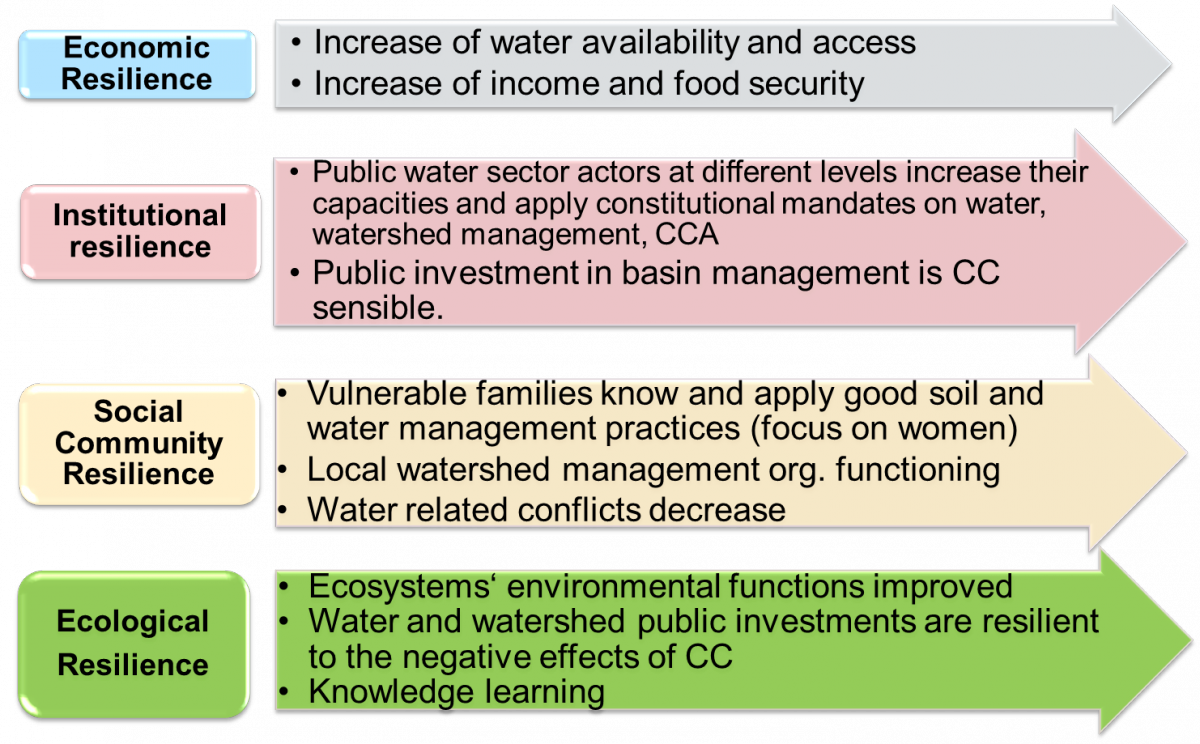The GESTOR Programme?s M&E from a Resilience Perspective
Although Bolivia - in the last years - has been able to reduce poverty and inequality, both still remain high, especially in the rural area. According to official measures, poverty decreased in a decade (2002-2012), from 63% to 45% , while the extreme poverty in the same time period, reduced from 37% to 22%. However, Bolivia still faces the challange to be a megadiverse country (cultural and ecological) with high level of rural poverty (61%)- a combination which makes the country very vulnerable to the negative effects of climate change. The increase of average temperature is causing changes to the hydrological cycle directly affecting the very vulnerable and poor rural population that depends on water management to sustain their livelihoods strategies. Hence, the Bolivian government has defined to build its climate resilience around the water sector at the basin level.
The 'Concerted Territorial Management of Natural Resources' Programme in Bolivia, or in spanish short GESTOR programme, is funded by the Swiss Agency for Development and Cooperation (SDC) and implemented by HELVETAS Swiss Intercooperation and other institutions since 2007. In its first phase (2007-2014), it has consolidated good governance practices and private and public institutional capacities for natural resource management in watershed management context. In its second phase, GESTOR -under the name of 'Gestión Integral del Agua' (GIA) -Integrated Water Management- evolved to mainstream climate change adaptation in the current public policy through the Plan Nacional de Cuencas (PNC)¬-National Watershed Plan, since Bolivia?s strategy to CCA is in the water management cycle. The USD 16 million programme has multiple outcomes that contribute to the resilience of socio ecological systems like coping capacity of 30.000 rural and vulnerable families, the institutional capacities of the national and subnational levels in 40 watersheds, and the integration of critical ecological functions and climate proofing of public investments. GESTOR's monitoring and evaluation system has also evolved from a focus on understanding the factors that contribute to sustainable livelihoods and resource governance, including participation and empowerment of principal stakeholders to an approach based on a resilience framework:

Image Source: Roy Córdova based on GIA Programme
GIA has operationally divided the resilience concept into four main development fields as it can be seen in the graphic. Within this framework, and in order to measure the indicators defined in each field- the M&E system will apply some of the methods and tools used in the first phase (development approach; sustainable livelihoods, resource governance, and empowerment) and also some new tools related to vulnerability and resilience. A brief list of the main indicators follows:

Image Source: Roy Córdova based on GIA Programme
In addition to the challenge of designing and implementing the GIA?S M&E, there is the challenge to consolidate the National Watershed Plan?s M&E beyond the project scope and mainstream it in climate change adaptation criteria. For this, we are planning to explore in-depth some of the M&E methods that were presented by other projects at the 2nd International Conference on Evaluation Climate Change and Development so to be able to apply them to the GIA?s M&E: i.e. vulnerability and resilience monitoring and evaluation tools, evaluating CC.
Finally, we would love to hear from you about your experiences where one M&W system requires input from others projects? M&E systems but indicator are not exactly the same as well as what do you think about measuring resilience by separate but related fields; that is, economic, social, institutional and ecological resilience.
Roy Córdova works as an M&E and Local Economic Development specialist in HELVETAS Swiss Intercooperation in Bolivia. He has been dealing with the design and implementation of M&E for development projects close to 15 years.



